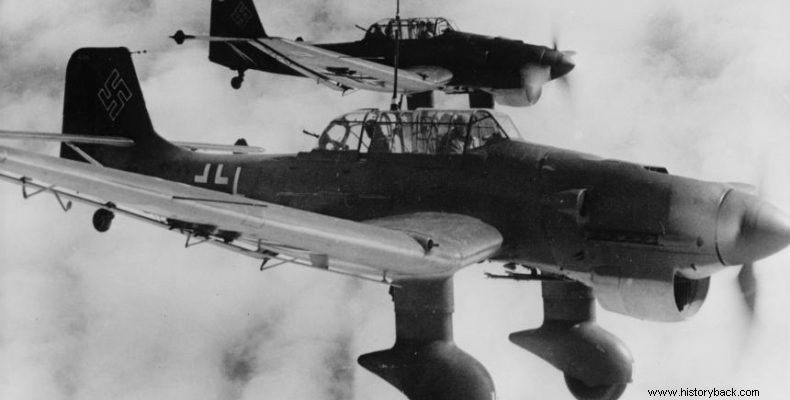
The idea of vertical bombardment was born in the interwar period. The Germans worked out all the emerging theories and came to the conclusion that vertical bombing provided many more advantages than the conventional way. In principle, it was accurate and allowed to attack the target point, as opposed to the classic method which was to attack the target area, so that some bombs hit the target as well.
So they proceeded to build their first vertical bomber, the small biplane Henschel Hs 123. This aircraft was tested in Spain during the Spanish Civil War and proved to be effective. At the same time, however, the Germans developed an even more powerful vertical-thrust bomber, which was to associate its name with the German Blitzkrieg, the Stuka.
The Stuka first flew in 1935. That model had two vertical stabilizers and a British engine. Two years later, in 1937, the production of the Stuka Ju-87A began, but it had a vertical fixed and German engine. It also had special aids to carry out vertical bombing.
The Ju-87A was soon replaced by the Ju-87B, which was also the first model to enter mass production and see combat action. It had a 1,100 hp Jumo engine and developed a maximum speed of 390 km. the hour. It was equipped with three 7.92 mm machine guns. (two in the wings, one in the rear part of the cockpit operated by the gunner) and could carry up to 700 kg of bombs.
Spain was initially sent one Ju-87A in 1936. In early 1938 three more A's were sent and later some B's. It was the B's that fought in Poland, the Netherlands, France and Greece. It was the Stukas that carried out the first operation of World War II. By order, either of Hitler, or of wing commander Udet, the Stukas were equipped with a siren, which they activated when submerging, in order to cause terror to the enemy.
Neither the Poles nor the Greeks, however, panicked, unlike the French in Sedan. Their presence in the Battle of Crete was a catalyst, where they caused particularly heavy losses to the British Navy.
In the Battle of Britain, their weaknesses were demonstrated for the first time. There, against British Spitfires and Hurricanes, they proved particularly easy targets and suffered crushing losses. Against Greece they used Stuka, granted by the Germans and the Italians.
On the Eastern Front things were more difficult. Although in the first phase of Operation Barbarossa, the Stukas inflicted heavy casualties on Soviet forces, destroying a great deal of Soviet aircraft on the ground, they proved to be in need of much improvement. Thus the Ju-87R long-range version was created. The next version was D. It had a more powerful engine, 1,300 hp and had a top speed of 408 km per hour and had a larger carrying capacity.
Version D was the most important and operated effectively on the Eastern Front. But against the threat of Soviet tanks, the G version was also developed, the anti-tank version of the Stuka . The Gs carried two 37mm guns. on the wings.
Another naval version of the Stuka, the Ju-87C, was developed for use on the planned German aircraft carrier, which was never completed . So the C's, which had the ability to launch a torpedo, were converted to D's and fought like the others.
A total of 6,500 Stukas, of all versions, were built , which operated, in addition to the German Air Force, with the Italian, Bulgarian, Croatian, Hungarian, Romanian and Slovak. An aircraft of this type was captured by the Americans, who used it in Tunisia in 1943. After the war, Stukas were also used extensively by the Yugoslavs.
The best Stuka pilot was Hans Ulrich Rudel, who destroyed 519 tanks, more than 1,000 other vehicles, 150 guns, 70 ships, shot down three Soviet aircraft and sank a Soviet battleship, two cruisers and a destroyer. Stalin had rewarded Rudel with 100,000 rubles.
